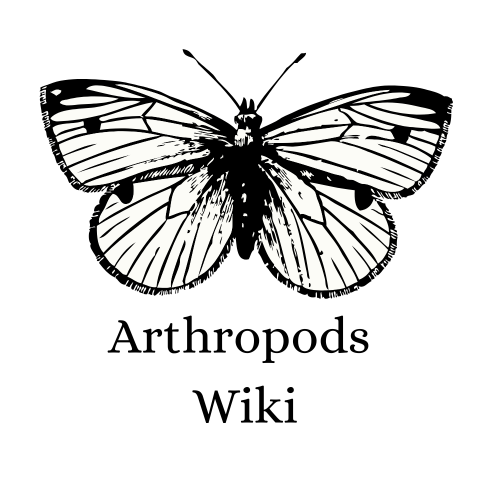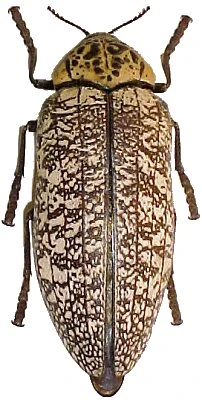|
Aaata finchi
| |
|
Buprestoidea
| |
|
Aaata finchi
| |
Aaata finchi (originally: Julodis finchi[1]) is a rare Buprestid species endemic to the Palearctic region and is the only species in the monotypic genus Aaata. This species was described by Waterhouse in 1884.[2]
Appearance[]
A. finchi is deemed as being the largest species of Wood-boring beetle native to the Palearctic and possibly the largest species in the family Buprestidae in the entire world.[3] The species displays sexual size dimorphism, with females being larger than males.[4] The species is fairly large with the finest ; most well-sought after specimens reaching an impressive 70 mm in length.[3][4][5] The surface of the body is, apart from the elevations of the surface sculpture, covered with a fine sand-like fuzz that resembles a setae. The Pronotum has a longitudinal impression in the middle and a curved, smooth, raised line, as well as a number of point elevations on each side. The wing tips are pleated with raised wrinkles, smooth and lustrous ; which do not appear to form any specific pattern. The colouration of the pronotum is much darker prominent in male specimen.[4] The colouration of the pronotum is piceous brown in females and chocolate-brown in males.[4] The head is black, with narrow frons posteriorly raised ; the Clypeus is reduced and shortened, the antennae are narrowly accumiated. The uniform brown colouration of the elytra is accompanied by irregular, blotchy brown markings.
Taxonomic history[]
The species A. finchi has a rather interesting taxonomic history, originally described as Julodis finchi this species was originally placed in the genus Julodis, the species name “Finchi” was named after B. Finch who donated the first ever A. finchi specimen to the London Zoological Society.[3][6] Later the species was placed in the monotypic genus Aaata by Semenow in 1906[3] when The species was distinguished from a Julodis species due to the variation between the sizes of the two respective species (70 for A. finchi and 20-40 mm for Julodis[3]).
Etymology[]
The derivation of the genus name “Aaata” often strikes curiosity in our minds due to the triple vowel making it the first genus in the animal kingdom using triple “a” in its name. The word may possibly be derived from the Greek work “aaatos” which means “Inviolable”.[3]
Ecology[]
Marketing value[]
Being an exceeding rarity among collectors, a fine and well-preserved A. finchi specimen is well-slight after often being sold for hundreds or thousands of euros, being deemed as one of the most expensive beetles among traders.[6]
Geographical distribution[]
Range[]
The range of this rare species is in Balochistan[5], a desert region in southeastern Iran , which extends partly to Pakistan and Afghanistan . Karachi is mentioned in the first description as the place of discovery.[6] A research study conducted on the Faunistic distribution of this species sheds some light on the habitat preferences for the species, specimens have been collected Balochistan Provinve, Pakistan, District Nushki have displayed potential endemism inspite of the species being Palearctic with its distribution coinciding with the Afrotropical desert regions.[4]
Habitat[]
The habitat preferences for the species is rather specific and peculiar, sandy dunes and semi-arid to arid areas, specimens have been observed living within the proximity of Tamarix plants.[4]
References[]
- ↑ https://m.wikidata.org/wiki/Q300667
- ↑ https://cerambycids.com/Buprestidae/WorldCat/Genera/Aaata.htm
- ↑ 3.0 3.1 3.2 3.3 3.4 3.5 https://www.gbif.org/species/100499238
- ↑ 4.0 4.1 4.2 4.3 4.4 4.5 https://www.entomoljournal.com/archives/2018/vol6issue2/PartW/6-1-352-188.pdf
- ↑ 5.0 5.1 https://www.inaturalist.org/taxa/709446-Aaata-finchi
- ↑ 6.0 6.1 6.2 https://fr.m.wikipedia.org/wiki/Aaata_finchi

